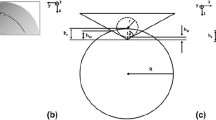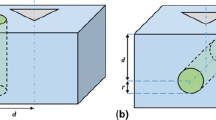Abstract
Nanoindentation of single microscale fibers is a challenging task due to the dimensional similarity of the probing instruments to the single-fiber cross sections. Algorithms customarily used in nanoindentation equipment assume that the indentation occurs in flat surfaces, thus simplifying the local geometry and approximating material properties in curved specimens. A modified Curved Area Function (mCAF) is developed using finite element analysis and tested using nanoindentation measurements of high-performance single microfibers. The mCAF accounts for the dimensions and curvature in the transverse direction of the cylindrical microfiber in conjunction with the contact depth and the impression of the indented area. The transverse direction indentation modulus of a \(12\,\upmu \hbox {m}\) of \(\hbox {Kevlar}^{\textregistered }\) KM2 fiber was estimated as \(7.76\, \pm \,0.22\) GPa. The computational results were corroborated with experimental measurements performed on KM2 single fibers and agreed with literature findings that assumed minor differences in testing equipment, area analysis, and projected surface area. Two geometry-related coefficients \( C_{0}\) and \(C_{1}\) were determined that facilitate simulation of fiber nanoindentations with diameters of \(d = 7, 15, 30, 40,\) and \(50\,\upmu \hbox {m}\) with indentation depths up to, and including, \(2\,\upmu \hbox {m}\). The mCAF provided a narrow measurement error of \(\pm \,0.22\) GPa (2.8%) when compared to published studies using the semi-infinite plane approximation, reinforcing the suitability of the developed model.








Similar content being viewed by others
References
Bencomo-Cisneros, J.A., Tejeda-Ochoa, A., García-Estrada, J.A., Herrera-Ramírez, C.A., Hurtado-Macías, A., Martínez-Sánchez, R., Herrera-Ramírez, J.M.: Characterization of Kevlar-29 fibers by tensile tests and nanoindentation. J. Alloys Compd. 536, S456–S459 (2012)
Bunsell, A.R.: The tensile and fatigue behaviour of Kevlar-49 (PRD-49) fibre. J. Mater. Sci. 10, 1300–1308 (1975)
Hadley, D.W., Ward, I.M., Ward, J.: The transverse compression of anisotropic fiber monofilaments. Proc. R. Soc. A 285, 275–286 (1965)
Pinnock, P.R., Ward, I.M., Wolfe, J.M.: The compression of anisotropic fiber monofilaments II. Proc. R. Soc. A 291, 267–278 (1966)
Rector, J.H., Slaman, M., Verdoold, R., Iannuzzi, D., Beekmans, S.V.: Optimization of the batch production of silicon fiber-top MEMS devices. J. Micromech. Microeng. 27, 1–10 (2017)
Swadener, J.G., George, E.P., Pharr, G.M.: The correlation of the indentation size effect measured with indenters of various shapes. J. Mech. Phys. Solids 50, 681–694 (2002)
Poon, B., Rittel, D., Ravichandran, G.: An analysis of nanoindentation in linearly elastic solids. Int. J. Solids Struct. 45, 6018–6033 (2008)
Bhushan, B.: Depth-sensing nanoindentation measurement techniques and applications. Microsyst. Technol. 23, 1595–1649 (2017)
Wierenga, P.E., Franken, A.J.J.: Ultramicroindentation apparatus for the mechanical characterization of thin films. J. Appl. Phys. 55, 4244–4247 (1984)
Oliver, W.C., Pharr, G.M.: An improved technique for determining hardness and elastic modulus using load and displacement sensing indentation experiments. J. Mater. Res. 7(6), 1564–1583 (1992)
Doerner, M.F., Nix, W.D.: A method for interpreting the data from depth-sensing indentation instruments. J. Mater. Res. 1(4), 601–609 (1986)
Garrido Maneiro, M.A., Rodríguez, J.: Pile-up effect on nanoindentation tests with spherical-conical tips. Scr. Mater. 52, 593–598 (2005)
Sargent, P.M., Page, T.F.: The possible effect of elastic recovery on the microhardness of anisotropic materials. Scr. Metall. 15, 245–250 (1981)
Kalman, D.P., Merrill, R.L., Wagner, N.J., Wetzel, E.D.: Effect of particle hardness on the penetration behavior of fabrics intercalated with dry particles and concentrated particle-fluid suspensions. ACS Appl. Mater. Interfaces 1, 2602–2612 (2009)
Decker, M.J., Egres, R.G., Wetzel, E.D., Wagner, N.J.: Low velocity ballistic properties of shear thickening fluid (STF)-fabric composites. In: Proceedings of 22nd International Symposium International Symposium on Ballistics, pp. 18–25 (2005)
Riekel, C., Davies, R.J.: Applications of synchrotron radiation micro-focus techniques to the study of polymer and biopolymer fibers. Curr. Opin. Colloid Interface Sci. 9, 396–403 (2005)
Li, S.F.Y., McGhie, A.J., Tang, S.L.: Comparative study of the internal structures of Kevlar and spider silk by atomic force microscopy. J. Vac. Sci. Technol. A 12, 1891–1894 (1994)
Gindl, W., Schöberl, T.: The significance of the elastic modulus of wood cell walls obtained from nanoindentation measurements. Compos. Part A 35, 1345–1349 (2004)
Vlassak, J.J., Nix, W.D.: Measuring the elastic properties of anisotropic materials by means of indentation experiments. J. Mech. Phys. Solids 42, 1223–1245 (1994)
Pharr, G.M., Herbert, E.G., Gao, Y.: The indentation size effect: a critical examination of experimental observations and mechanistic interpretations. Annu. Rev. Mater. Res. 40, 271–292 (2010)
Ghanbari, S., Bahr, D.F.: An energy-based nanoindentation method to assess localized residual stresses and mechanical properties on shot-peened materials. J. Mater. Res. 34(7), 1121–1129 (2019)
Cheng, M., Chen, W., Weerasooriya, T.: Mechanical Properties of Kevlar®KM2 Single Fiber. J. Eng. Mater. Technol. 127, 197–203 (2005)
Deteresa, S.J., Allen, S.R., Farris, R.J., Porter, R.S.: Compressive and torsional behaviour of Kevlar 49 fibre. J. Mater. Sci. 19, 57–72 (1984)
McAllister, Q.P., Gillespie Jr., J.W., VanLandingham, M.R.: Evaluation of the three-dimensional properties of Kevlar across length scales. J. Mater. Res. 27(14), 1824–1837 (2012)
McAllister, Q.P., Gillespie Jr., J.W., VanLandingham, M.R.: Nonlinear indentation of fibers. J. Mater. Res. 27(1), 197–213 (2012)
Cole, D.P., Strawhecker, K.E.: An improved instrumented indentation technique for single microfibers. J. Mater. Res. 29(9), 1104–1112 (2014)
Kawabata, S.: Measurement of the transverse mechanical properties of high-performance fibres. J. Text. Inst. 81, 432–447 (1990)
Leal, A.A., Deitzel, J.M., Gillespie Jr., J.W.: Compressive strength analysis for high performance fibers with different modulus in tension and compression. J. Compos. Mater. 43, 661–674 (2009)
Singletary, J., Davis, H., Ramasubramanian, M.K., Knoff, W.: The transverse compression of PPTA fibers Part I Single fiber transverse compression testing. J. Mater. Sci. 35, 573–581 (2000)
Singletary, J., Davis, H., Song, Y., Ramasubramanian, M.K., Knoff, W.: The transverse compression of PPTA fibers Part II Fiber transverse structure. J. Mater. Sci. 35, 583–592 (2000)
Raju, H., Pelegri, A.A.: Experimental investigation of transverse mechanical properties of high-performance Kevlar KM2 single fiber. In: ASME 2017 International Mechanical Engineering Congress and Exposition V014T11A045 (2017)
Li, X., Bhushan, B.: A review of nanoindentation continuous stiffness measurement technique and its applications. Mater. Charact. 48, 11–36 (2002)
Pharr, G.M., Strader, J.H., Oliver, W.C.: Critical issues in making small-depth mechanical property measurements by nanoindentation with continuous stiffness measurement. J. Mater. Res. 24, 653–666 (2009)
Hanson, M.T.: The elastic field for conical indentation including sliding friction for transverse isotropy. J. Appl. Mech. 59, S123–S130 (1992)
Hanson, M.T.: The elastic field for spherical Hertzian contact including sliding friction for transverse isotropy. J. Tribol. 114, 606–611 (1992)
Chicot, D., Yetna N’Jock, M., Puchi-Cabrera, E.S., Iost, A., Staia, M.H., Louis, G., Bouscarrat, G., Aumaitre, R.: A contact area function for Berkovich nanoindentation: application to hardness determination of a TiHfCN thin film. Thin Solid Films 558, 259–266 (2014)
Sakharova, N.A., Fernandes, J.V., Antunes, J.M., Oliveira, M.C.: Comparison between Berkovich, Vickers and conical indentation tests: a three-dimensional numerical simulation study. Int. J. Solids Struct. 46, 1095–1104 (2009)
Briscoe, B.J., Fiori, L., Pelillo, E.: Nano-indentation of polymeric surfaces. J. Phys. D Appl. Phys. 31, 2395–2405 (1998)
Wang, J.S., Zheng, X.J., Zheng, H., Zhu, Z., Song, S.T.: Evaluation of the substrate effect on indentation behavior of film/substrate system. Appl. Surf. Sci. 256, 5998–6002 (2010)
Jiang, W.G., Su, J.J., Feng, X.Q.: Effect of surface roughness on nanoindentation test of thin films. Eng. Fract. Mech. 75, 4965–4972 (2008)
Nano Test Vantage User Manual, Indenter Area Function, Micro Materials Ltd Excellence in Nano-mechanics
Sahin, K., Clawson, J.K., Singletary, J., Horner, S., Zheng, J., Pelegri, A.A., Chasiotis, I.: Limiting role of crystalline domain orientation on the modulus and strength of aramid fibers. Polymer 140, 96–106 (2018)
Swadener, J.G., Pharr, G.M.: Indentation of elastically anisotropic half-spaces by cones and parabolae of revolution. Philos. Mag. A 81, 447–466 (2001)
Acknowledgements
The authors kindly acknowledge the financial support of PEO Soldier of the United States Army Contract W91CRB-12-P-0047 P00003 to perform this research.
Author information
Authors and Affiliations
Corresponding author
Additional information
Publisher's Note
Springer Nature remains neutral with regard to jurisdictional claims in published maps and institutional affiliations.
Rights and permissions
About this article
Cite this article
Turla, P., Patel, H. & Pelegri, A.A. On the transverse indentation moduli of high-performance KM2 single fibers using a curved area function. Acta Mech 231, 2113–2124 (2020). https://doi.org/10.1007/s00707-020-02645-3
Received:
Revised:
Published:
Issue Date:
DOI: https://doi.org/10.1007/s00707-020-02645-3




